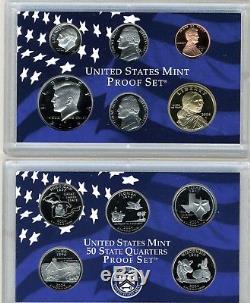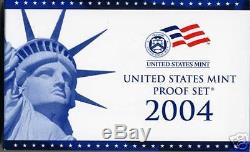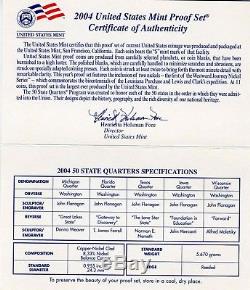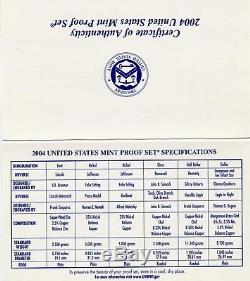2004 US MINT PROOF SET With 50 STATE QUARTERS & COA





11115 Pine Bank Ct Fort Wayne, IN 46845. 2004 United States Mint Proof Set.. 50 State Quarters & COA. Yes, this is hard to find Proof Set that everyone wants to have in their Collection! Mint Proof Set with 50 State Quarters (Michigan, Florida, Texas, Iowa & Wisconsin) from my private collection, which comes with and a COA from the U. You'll love this popular set which came direct from the U. Just look at the actual detailed scan to see what I mean!!
This would be an excellent addition to any coin collection or a great gift for a person you love! It would be a wonderful gift for any event like a birthday, graduation, anniversary or other special occasions! We only have one of these left, so order now! 26.73 grams total weight.
0.77344 oz pure silver. ABOUT THE MORGAN SILVER DOLLAR COINS. Political pressure, not public demand, brought the Morgan dollar into being. There was no real need for a new silver dollar in the late 1870s; the last previous cartwheel, the Liberty Seated dollar, had been legislated out of existence in 1873, and hardly anyone missed it. Silver-mining interests did miss the dollar, though, and lobbied Congress forcefully for its return.After several futile attempts, the silver forces in Congressled by Representative Richard (Silver Dick) Bland of Missourifinally succeeded in winning authorization for a new silver dollar when Congress passed the Bland-Allison Act on February 28, 1878. This amounted to a massive subsidy, coming at a time when the dollars face value exceeded its intrinsic worth by nearly 10%. In November 1877, nearly four months before passage of the Bland-Allison Act, the Treasury saw the handwriting on the wall and began making preparations for a new dollar coin. Linderman ordered Chief Engraver William Barber and one of his assistants, George T.
Morgan, to prepare pattern dollars, with the best design to be used on the new coin. Actually, Linderman fixed this contest in Morgans favor; he had been dissatisfied with the work of the two BarbersWilliam and his son, Charlesand in 1876 had hired Morgan, a talented British engraver, with plans to entrust him with new coin designs. At that time, resumption of silver dollar coinage was not yet planned, and Morgan began work on designs intended for the half dollar. Following Lindermans orders that a head of Liberty should replace the full-figure depiction then in use, Morgan recruited Philadelphia school teacher Anna Willess Williams to pose for the new design. Morgans obverse features a left-facing portrait of Miss Liberty.
The reverse depicts a somewhat scrawny eagle which led some to vilify the coin as a buzzard dollar. The designers initial M appears on both sidesa first. Its on the truncation of Libertys neck and on the ribbons left loop on the reverse. Mintmarks (O, S, D, and CC) are found below the wreath on the reverse.Points to check for wear on Morgans are the hair above Libertys eye and ear, the high upper fold of her cap and the crest of the eagles breast. Soon after production began, someone advised the Mint that the eagle should have seven tail feathers, instead of the eight being shown, and Linderman ordered this change. As a result, some 1878 Morgan dollars have eight feathers, some sevenand some show seven over eight.
The seven-over-eight variety is the scarcest, though all are fairly common. More than half a billion Morgan dollars were struck from 1878 through 1904, with production taking place at the main mint in Philadelphia and the branches in New Orleans, San Francisco and Carson City. Carson City production was generally much lower and ended altogether after that branch was closed in 1893. The coin came back for one final curtain call in 1921, when more than 86 million examples were produced under the terms of the Pittman Act at Philadelphia, San Francisco and Denverbut that was a double-edged sword: Under the 1918 legislation, more than 270 million older silver dollars, almost all Morgans, had been melted.
The law required replacements for these, but most were of the Peace design, which replaced the Morgan version at the end of 1921. In all, some 657 million Morgan dollars were produced in 96 different date-and-mint combinations. Hundreds of millions were melted over the yearsby the government under the Pittman Act and the Silver Act of 1942, and by private refiners since the late 1960s, when rising silver prices made this profitable. Despite all the melting, Americans had more than enough Morgans to fill their daily needs, since the dollars circulated regularly only in the West. As a result, huge stockpiles remained in the Treasurys vaults, as well as bank vaults nationwide.
This explains why so many Morgan dollars are so well preserved today despite their age; few saw actual use. Even as the numismatic hobby underwent rapid growth beginning in the 1930s, interest in other collecting areas far outpaced the attention paid to the large Morgan cartwheels.
Most collectors preferred the lower face-value coins (with their lower cost) that were readily available in circulation. Although it was possible to order silver dollars through banks or directly from the Treasury, few noticed or cared. More than a few dealers quietly exploited this discovery throughout the 1940s and 50s. In the early 1960s, with silver rising in price, opportunists recognized the chance to turn fast profits by redeeming silver certificates for dollar coinsmostly Morgansat the Treasury.
By the time the government closed this lucrative window in 1964, only 2.9 million cartwheels were left in its vaults, almost all of them scarce Carson City Morgans. Interest in Morgans was further heightened by the publicity surrounding the 400,000+ dollars found in the basement of Nevada eccentric LaVere Redfields home. The coins were cooperatively marketed by a number of dealers over a period of several years. Rather than depressing prices, the orderly dispersal of these coins only served to bring more collectors into the Morgan dollar fold. Similarly, the early 1980s witnessed the equally successful distribution of the 1.5 million silver dollars in the Continental Bank hoard.
The Morgan dollars story is a Cinderella tale: Until the 1960s, it was largely ignored by the public. Since then, it has gradually become among the most widely pursued and desired of all U. Although many collectors find the challenge of assembling a complete date and mintmark set in Mint State compelling, others satisfy themselves with collecting just one coin per year. Exceptional specimens are also sought after by type collectors. Major keys include 1895, 1893-S, 1895-O, 1892-S, 1889-CC, 1884-S and 1879-CC.
Mint records show that 12,000 business-strike dollars were made in Philadelphia in 1895, but only proofs are known; the mintage of these is 880. Proofs were made for every year in the series, but only a few brilliant proofsvariously reported at 15 to 24are known for 1921. Prooflike Morgans also are highly prized and are collected in both Prooflike (PL) and Deep-Mirror Prooflike (DPL or DMPL). History have been greeted with more indifference at the time of their release than this silver dollar.
And few, if any, have then gone on to stimulate such passionate excitement among collectors. Diameter: 38.1 millimeters Weight: 26.73 grams Composition. 100 copper Edge: Reeded Net Weight. The major coin shows are continuing to generate record sales on the trading floor and in the auctions.
Most coin dealers are quoting prices well over current market levels for high-grade rare coins. By the end of this show, many dealers and serious collectors became believers and were prepared to pay 5-10% more to acquire nice material than earlier in the show. Remember, coin prices are still at 40-50% of their 1990 highs. These current coin shows have confirmed that 2003 is the year that high-grade numismatics started a major rally. The excitement and heavy trading at coin shows are much like back in 1987, just before high-grade rare coin prices skyrocketed 50 to 200% in a three-year period.
The item "2004 US MINT PROOF SET With 50 STATE QUARTERS & COA" is in sale since Friday, March 31, 2006. This item is in the category "Coins & Paper Money\Coins\ US\Proof Sets". The seller is "cashconnection2" and is located in Fort Wayne, Indiana. This item can be shipped to United States, Canada, United Kingdom, Denmark, Romania, Slovakia, Bulgaria, Czech republic, Finland, Hungary, Latvia, Lithuania, Malta, Estonia, Australia, Greece, Portugal, Cyprus, Slovenia, Japan, Sweden, Indonesia, Belgium, France, Hong Kong, Ireland, Netherlands, Poland, Spain, Italy, Germany, Austria, Singapore, Norway, Saudi arabia, United arab emirates, Bahrain, Croatia, Malaysia, Chile, Colombia, Costa rica, Dominican republic, Panama, Trinidad and tobago, Guatemala, El salvador, Honduras, Jamaica.
